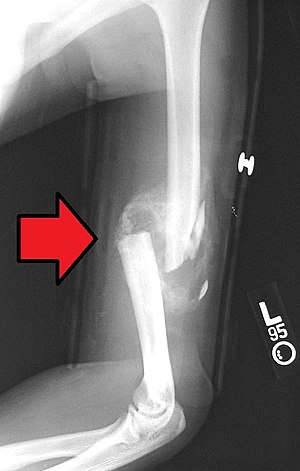Fractures of the diaphysis of the humerus
From WikiLectures
- are caused by direct and indirect mechanisms (blow, fall, ...)
- frequent fracture during overstretching (popularly lever) due to torsional force
- definition of the diaphysis of the humerus - proximally the tendon of the m. pectoralis major, distally 4 cm above the elbow
AO classification[edit | edit source]
A – simple (I – spiral, II – oblique, III – transverse)
B – wedge-shaped (I – spiral wedge, II – bending wedge, III – split wedge)
C – complex
dislocation of the proximal fragment (according to this, then adduction or abduction fracture)
- fracture above the tendon of m. deltoideus – traction m. pectoralis major into adduction
- fracture above the tendon of m. deltoideus – traction m. deltoideus into abduction
Clinical signs and diagnosis[edit | edit source]
- classic symptoms of fracture (pain, deformity, pathological mobility, oedema and heematoma, crepitations)
- it is necessary to examine the pulse on the a. radialis and innervation of the nervus radialis (sensitivity + motor - wrist and finger extensions)
- X-ray in two projections (also view of adjacent joints - shoulder + elbow)
Complications[edit | edit source]
- n. radialis and a. brachialis injuries (it is necessary to examine innervation + pulse of a. radialis)
- Late complications include the formation of a tuberosity and irritation of the n. radialis by hyperthrophic muscle
Treatment[edit | edit source]
Conservative[edit | edit source]
- repositioning,
- fixation (hanging cast, Desault, abduction splint, circular brace - functional treatment according to Sarmiento),
- early warm-up of the shoulder
- acceptable for conservative treatment are dislocation up to ½ diaphyseal width, shortening up to 1 cm, angulation up to 25°, immobilization for 4-12 weeks,
surgical[edit | edit source]
- if not repairable, concomitant neurovascular injury, open fractures
- nitra-articular osteosynthesis (most common - secured nail, ante- or retrograde) - transverse, short oblique and splinter
- splint osteosynthesis (DCD – dynamic compression plate) – spiral and long-angled fractures, injuries of the n. radialis
- external fixation – open fractures with soft tissue damage, polytrauma
Links[edit | edit source]
Related articles[edit | edit source]
Source[edit | edit source]
- PASTOR, Jan. Langenbeck's medical web page [online]. [cit. 2022-16-12]. <http://langenbeck.webs.com>.

